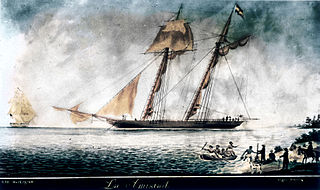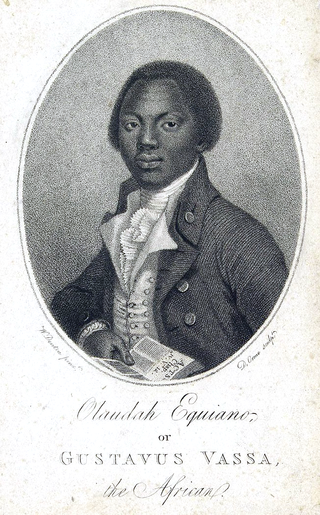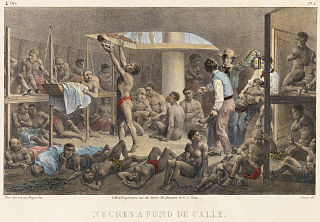The slave narrative is a type of literary genre involving the (written) autobiographical accounts of enslaved persons, particularly Africans enslaved in the Americas, though many other examples exist. Over six thousand such narratives are estimated to exist; about 150 narratives were published as separate books or pamphlets. In the United States during the Great Depression (1930s), more than 2,300 additional oral histories on life during slavery were collected by writers sponsored and published by the Works Progress Administration, a New Deal program. Most of the 26 audio-recorded interviews are held by the Library of Congress.

The Atlantic slave trade or transatlantic slave trade involved the transportation by slave traders of enslaved African people to the Americas. European slave ships regularly used the triangular trade route and its Middle Passage. Europeans established a coastal slave trade in the 15th century and trade to the Americas began in the 16th century, lasting through the 19th century. The vast majority of those who were transported in the transatlantic slave trade were from Central Africa and West Africa and had been sold by West African slave traders to European slave traders, while others had been captured directly by the slave traders in coastal raids. European slave traders gathered and imprisoned the enslaved at forts on the African coast and then brought them to the Americas. Some Portuguese and Europeans participated in slave raids. As the National Museums Liverpool explains: "European traders captured some Africans in raids along the coast, but bought most of them from local African or African-European dealers." Many European slave traders generally did not participate in slave raids because life expectancy for Europeans in sub-Saharan Africa was less than one year during the period of the slave trade because of malaria that was endemic in the African continent. An article from PBS explains: "Malaria, dysentery, yellow fever, and other diseases reduced the few Europeans living and trading along the West African coast to a chronic state of ill health and earned Africa the name 'white man's grave.' In this environment, European merchants were rarely in a position to call the shots." The earliest known use of the phrase began in the 1830s, and the earliest written evidence was found in an 1836 published book by F. H. Rankin. Portuguese coastal raiders found that slave raiding was too costly and often ineffective and opted for established commercial relations.

The Middle Passage was the stage of the Atlantic slave trade in which millions of enslaved Africans were transported to the Americas as part of the triangular slave trade. Ships departed Europe for African markets with manufactured goods, which were then traded for slaves with rulers of African states and other African slave traders. Slave ships transported the slaves across the Atlantic. The proceeds from selling slaves were then used to buy products such as furs and hides, tobacco, sugar, rum, and raw materials, which would be transported back to Europe to complete the triangle.

Triangular trade or triangle trade is trade between three ports or regions. Triangular trade usually evolves when a region has export commodities that are not required in the region from which its major imports come. It has been used to offset trade imbalances between different regions.

Thomas Clarkson was an English abolitionist, and a leading campaigner against the slave trade in the British Empire. He helped found the Society for Effecting the Abolition of the Slave Trade and helped achieve passage of the Slave Trade Act 1807, which ended British trade in slaves.

Olaudah Equiano, known for most of his life as Gustavus Vassa, was a writer and abolitionist. According to his memoir, he was from the village of Essaka in modern southern Nigeria. Enslaved as a child in West Africa, he was shipped to the Caribbean and sold to a Royal Navy officer. He was sold twice more before purchasing his freedom in 1766.

Narrative of the Life of Frederick Douglass, an American Slave is an 1845 memoir and treatise on abolition written by African-American orator and former slave Frederick Douglass during his time in Lynn, Massachusetts. It is the first of Douglass's three autobiographies, the others being My Bondage and My Freedom (1855) and Life and Times of Frederick Douglass.

The Slave Coast is a historical name formerly used for that part of coastal West Africa along the Bight of Biafra and the Bight of Benin that is located between the Volta River and the Lagos Lagoon. The name is derived from the region's history as a major source of African people sold into slavery during the Atlantic slave trade from the early 16th century to the late 19th century.

Slavery in the British and French Caribbean refers to slavery in the parts of the Caribbean dominated by France or the British Empire.

Slave ships were large cargo ships specially built or converted from the 17th to the 19th century for transporting slaves. Such ships were also known as "Guineamen" because the trade involved human trafficking to and from the Guinea coast in West Africa.

La Amistad was a 19th-century two-masted schooner owned by a Spaniard living in Cuba. It became renowned in July 1839 for a slave revolt by Mende captives who had been captured and sold to European slave traders and illegally transported by a Portuguese ship from West Africa to Cuba, in violation of European treaties against the Atlantic slave trade. Spanish plantation owners Don José Ruiz and Don Pedro Montes bought 53 captives in Havana, Cuba, including four children, and were transporting them on the ship to their plantations near Puerto Príncipe. The revolt began after the schooner's cook jokingly told the slaves that they were to be "killed, salted, and cooked." Sengbe Pieh unshackled himself and the others on the third day and started the revolt. They took control of the ship, killing the captain and the cook. Two Africans were also killed in the melee.

The Interesting Narrative of the Life of Olaudah Equiano, Or Gustavus Vassa, The African, first published in 1789 in London, is the autobiography of Olaudah Equiano, an African from what is now Nigeria who was enslaved in childhood and eventually earned his freedom and became an abolitionist in the United Kingdom.

The history of slavery spans many cultures, nationalities, and religions from ancient times to the present day. Likewise, its victims have come from many different ethnicities and religious groups. The social, economic, and legal positions of slaves have differed vastly in different systems of slavery in different times and places.

Slavery has historically been widespread in Africa. Systems of servitude and slavery were once commonplace in parts of Africa, as they were in much of the rest of the ancient and medieval world. When the trans-Saharan slave trade, Red Sea slave trade, Indian Ocean slave trade and Atlantic slave trade began, many of the pre-existing local African slave systems began supplying captives for slave markets outside Africa. Slavery in contemporary Africa is still practised despite it being illegal.
Seasoning, or the Seasoning, was the period of adjustment that slave traders and slaveholders subjected African slaves to following their arrival in the Americas. While modern scholarship has occasionally applied this term to the brief period of acclimatization undergone by European immigrants to the Americas, it most frequently and formally referred to the process undergone by enslaved people. Slave traders used the term "seasoning" to refer to the process of adjusting the enslaved Africans to the new climate, diet, geography, and ecology of the Americas. The term applied to both the physical acclimatization of the enslaved person to the environment, as well as that person's adjustment to a new social environment, labor regimen, and language. Slave traders and owners believed that if slaves survived this critical period of environmental seasoning, they were less likely to die and the psychological element would make them more easily controlled. This process took place immediately after the arrival of enslaved people during which their mortality rates were particularly high. These "new" or "saltwater" slaves were described as "outlandish" on arrival. Those who survived this process became "seasoned", and typically commanded a higher price in the market. For example, in eighteenth century Brazil, the price differential between "new" and "seasoned" slaves was about fifteen percent.

Slavery on the Barbary Coast refers to the enslavement of people taken captive by the Barbary corsairs of North Africa.

A scramble was a particular form of slave auction that took place during the Atlantic slave trade in the European colonies of the West Indies and the domestic slave trade of the United States. It was called a "scramble" because buyers would run around in an open space all at once to gather as many enslaved people as possible. Another name for a scramble auction is "Grab and go" slave auctions. Slave ship captains would go to great lengths to prepare their captives and set prices for these auctions to make sure they would receive the highest amount of profits possible because it usually did not involve earlier negotiations or bidding.

Panyarring was the practice of seizing and holding persons until the repayment of debt or resolution of a dispute which became a common activity along the Atlantic coast of Africa in the 18th and 19th centuries. The practice developed from pawnship, a common practice in West Africa where members of a family borrowing money would be pledged as collateral to the family providing credit until the repayment of the debt. Panyarring though is different from this practice as it involves the forced seizure of persons when a debt was not repaid.

Black Cargoes: A History of the Atlantic Slave Trade 1518–1865 by Daniel P. Mannix in collaboration with Malcolm Cowley was published in 1962 during the civil rights movement in the United States prior to the passage of the Civil Rights Act of 1964. It was the first book on the Atlantic slave trade since The American Slave Trade: An Account of Its Origin, Growth and Suppression published in 1900 by John Randolph Spears. It had a narrative format and was widely recognized in the popular press at the time including Time magazine and the New York Times and was praised in academic articles. The New York Times review indicated that its subject had "special current overtones". One of the chapters, The Middle Passage was published separately in American Heritage magazine, also in 1962.













